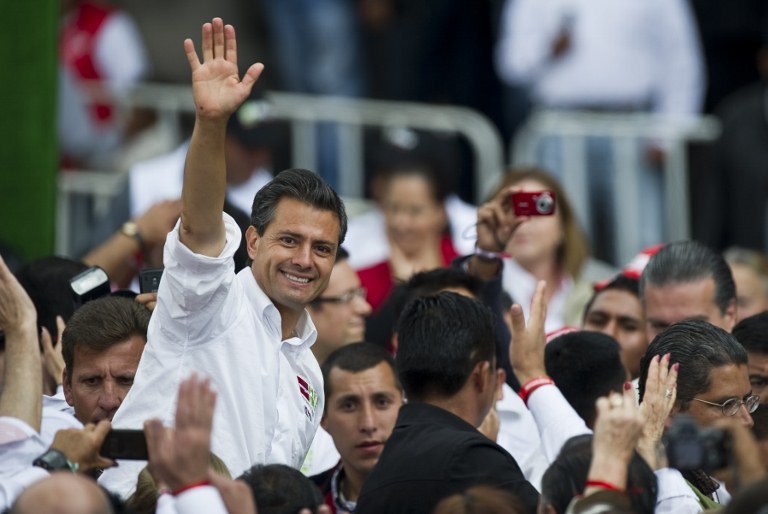SUMMARY
This is AI generated summarization, which may have errors. For context, always refer to the full article.

TOLUCA, Mexico – Enrique Peña Nieto, the man polls say will be elected Mexico’s next president, wrapped up his national campaign Wednesday, June 27, with a colorful rally in the city that saw his political rise.
Thousands of supporters dressed in red and white, the campaign colors, waved banners and chanted slogans in the main Toluca town square as their candidate vowed victory in Sunday’s presidential vote.
“We want a country at peace for all Mexicans, with safety and security,” Peña Nieto told a crowd packed into Toluca’s main square, who chanted “Enrique, Enrique!”
He called for a “new direction” for the country, “so that each Mexican family can obtain a higher income,” and promised more money for Mexican farmers, lower utility rates and an overhaul of the social security system.
“My priority will be to battle the poverty in our country at its roots,” he told the crowd.
But he not mention the violence plaguing the country, which has left more than 50,000 dead since President Felipe Calderon deployed the military to crack down on drug cartels in late 2006.
Peña Nieto is running well ahead in Wednesday’s latest polls — by law the final ones before the Sunday vote — which predict he will win by a 10-17 point margin over Andres Lopez Obrador from the leftist Party of the Democratic Revolution (PRD).
Josefina Vazquez Mota, bidding to be the Latin American nation’s first woman president, and who represents Calderon’s ruling conservative National Action Party (PAN), is running third with about 24 percent support.
By law Calderon cannot run for re-election.
And Peña Nieto has presented himself as the fresh new face of the PRI, which governed Mexico for most of the 20th century and has been tainted by charges of corruption and cronyism.
The handsome, telegenic 45-year-old has run a model campaign, attracting a loyal fan base, appearing in photos with other youthful candidates — often women — and rubbing shoulders with local celebrities.
He is married to telenovela star Angelica Rivera, his second wife, star of Televisa’s hit soap “Distilling Love.”
One enthusiastic supporter, Margarita Hernandez, 47, and her group of female PRI loyalists made their feelings plain.
“Enrique, bombon, I want you on my mattress!” she cried out, smiling.
As soon as he finished speaking, a muscular fellow in a tight v-neck t-shirt jumped on stage to hug him. “Oooh, that’s Alejandro Fernandez!” cried out a middle-aged woman, referring to a well-known Mexican ranchera and pop singer.
Peña Nieto was returning home to Toluca, the capital of Mexico State for his final campaign stop, paying tribute to the city where he cut his teeth as a politician, eventually rising to become state governor in 2005.
He also married his second wife in Toluca cathedral, on the town square, the Martyr’s Plaza, named after independence war heroes executed there in 1811.
On Wednesday the cathedral’s giant bronze bells rang out every 15 minutes, loud enough to be heard above the music and speeches blasting from giant campaign speakers.
“For me, he is the candidate of unity, comradeship and victory,” said PRI loyalist Erick Aguila.
Aguila, 27, an economist by training, said he joined the party at age 18 after comparing the other political options. Now he actively supports local candidates in the nearby city of Metepec.
Peña Nieto “inspires me to continue working hard at a local level,” he said.
Toluca, population 800,000 and sitting some 2,600 meters (8,500 feet) above sea level west of Mexico City, was a backwater until the 1960s, when an industrial corridor opened and auto and textile factories moved in. – Carlos Hamann, Agence France-Presse
Add a comment
How does this make you feel?
There are no comments yet. Add your comment to start the conversation.